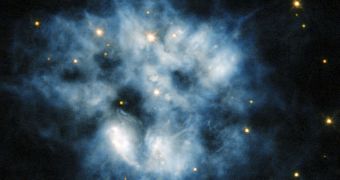NASA is back in business, after the end of the US government shutdown. On the one hand, this means all the research and planning for future missions is underway again, on the other, it means we get more spectacular images like this nebula seen by Hubble.
"This NASA/ESA Hubble Space Telescope image shows the planetary nebula NGC 2452, located in the southern constellation of Puppis. The blue haze across the frame is what remains of a star like our sun after it has depleted all its fuel," NASA explains.
"At the center of this blue cloud lies what remains of the nebula's progenitor star. This cool, dim, and extremely dense star is actually a pulsating white dwarf, meaning that its brightness varies over time as gravity causes waves that pulse throughout the small star's body," it adds.
NGC 2452 isn't new to science, we've known about it for almost two centuries now. In the 19th century, astronomers were not quite sure what these fuzzy gaseous objects were, but they believed them to be linked to planets, which is how they got their name, planetary nebulae.
We now know that they are formed by the destruction of stars similar in size to our sun, but the name has stuck.

 14 DAY TRIAL //
14 DAY TRIAL //